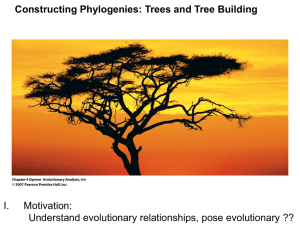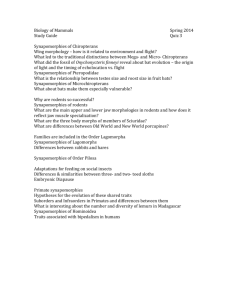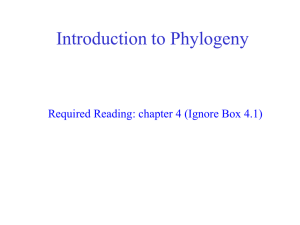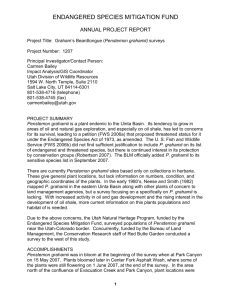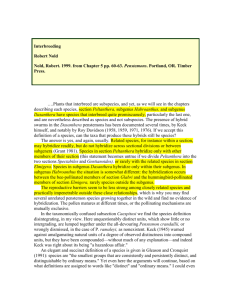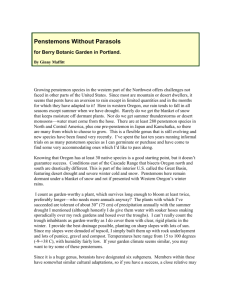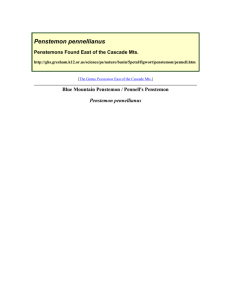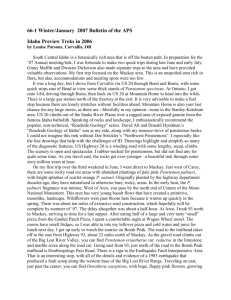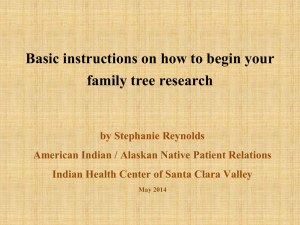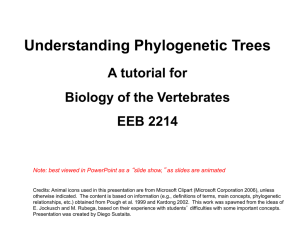Estimating Phylogeny
advertisement
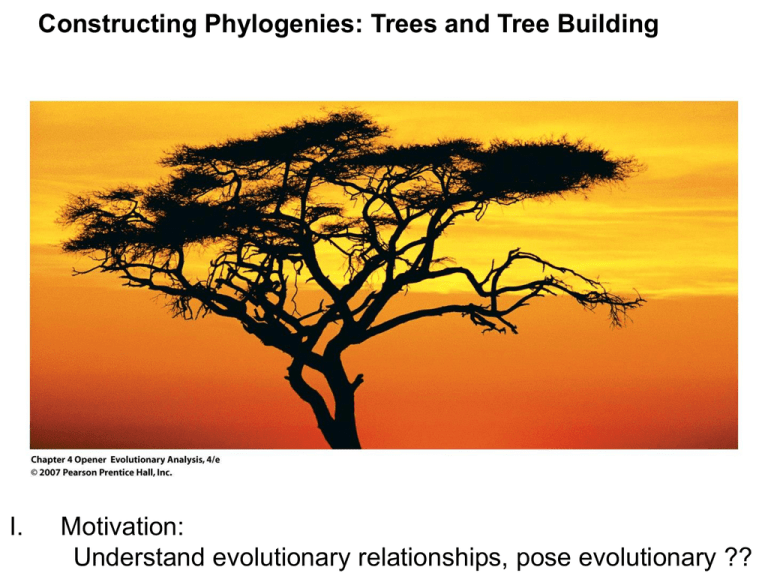
Constructing Phylogenies: Trees and Tree Building I. Motivation: Understand evolutionary relationships, pose evolutionary ?? Evolution of Humans Species related to us Photos by: Andrea D. Wolfe© and Wayne J. Elisens© (close-up photo) Location: Campus of University of Oklahoma (Norman, Oklahoma) II. Methods Penstemon oklahomensis is a member of Penstemon subg. Penstemon sect. Penstemon subsect. Penstemon (Bennett et al. 1987). Its common name is Oklahoma Beardtongue, and it is one of just a few plants found only in Oklahoma. Penstemon oklahomensis is also unusual in having a closed throat, which limits nectar access to large bumblebees.. Penstemon barbatus is a member of Penstemon subg. Habroanthus sect. Elmigra. It has a typical hummingbird floral syndrome. Notice the reflexed lower lip. Many of the red-flowered penstemons have a straight corolla without this reflexed lower lip. This species can be found in Arizona, Colorado, New Mexico, Texas, Utah and Mexico. Different Approaches: Cladistic vs. Phenetic Methods Species Life span Growth form Flower size Flower color Nectar production Ancestor annual herb short white low Species 1 annual herb short white low Species 2 annual herb short white high Species 3 perennial tree long red high Phenetic (overall similarity) Sp 1 2 Cladistic (shared and derived 3 1 2 3 High nectar Derived state Ancestor: Annual, herb, short and white flowers with low nectar production Synapomorphies: Traits that are shared and derived and reveal evolutionary branch point IV. Synapomorphies in Phylogenetic Reconstruction Synapomorphies arise in shared ancestral populations and are passed onto descendant populations, thus defining branching points. Synapomorphies are homologous As you move up through a tree, from ancestor to descendant clades there are more and more synapomorphies. Synapomorphies are nested. Construct Tree by a series of nested shared and derived events or character state transitions III. Monophyly vs. Paraphyly Monophyletic groups are comprised of an ancestor & all of its descendants (=clades or lineages) Monophyly vs paraphyly: Angiosperm Eudicots Magnoliales Monocots Austrobaileyaceae Nymphaeceae Amborella Outgroup Gymnosperms Monophyletic group: All descendants of a common ancestor Vs. Some but not all descendants Major Monophyletic groups of tetrapods Synapomorphies reveal the relationships among tetrapods Trees built from synapomorphies = cladograms V. The Right Traits The importance of recognizing and using homologous traits versus shared traits reflecting homoplasy Homology: A trait that is similar between two species because of inheritance of that trait from a common ancestor Homoplasy: A trait that is similar between two species because of convergent evolution, parallelism or reversal, but not because of shared ancestry Homoplasy: A trait that is similar between two species because of convergent evolution, parallelism or reversal, but not because of shared ancestry Convergent evolution: Similarity between species that is caused by a similar but evolutionarily independent response to similar selection pressures (great evidence for an adaptation). Ancestors are different in appearance, but the two descendants now look alike for that trait. Parallelism: The independent acquisition in 2 or more related descendant species of similar derived character (great evidence for an adaptation, often same genes, but different alleles). Ancestors look similar and so do the descendants. Reversal: return to an ancestral condition Parallel Evolution of Mating System Eichhornia paniculata Brazil South Brazil North South x North Fenster and Barrett 1995 Length of Filament Convergent evolution of succulence: Euphorbiaceae left, Cactaceae right The trait succulence is a homoplasy arising from convergent evolution Convergent evolution within mammals Marsupial Tasmanian wolf Grey Wolf The skulls of the Thylacine (left) and the Grey Wolf, Canis lupus, are almost identical, although the species are only very distantly related (different infraclasses). The skull shape of the Red Fox, Vulpes vulpes, is even closer to that of the Thylacine. VI. Parsimony: least number of steps to construct a phylogeny Using parsimony to distinguish homology from homoplasy (Tree made from DNA synapomorphies) (also development) Gene co-option in the crystallins (H2O soluble proteins) of animal eye lenses Use Parsimony to create tree VII. Systematic relationships of the whale Odd toed (horses) Even toed (deer) artiodactyl The astragalus is a syanpomorphy that defines artiodactyls Whales share many features with ungulates. Which ungulates share the most recent common ancestor with whales? Artiodactyla Hypothesis Outgroup = Perissodactyla (horses and rhinos;odd toed). 60 nucleotides of aligned sequence from a milk-protein gene in six artiodactyls Synapomorphies = shared & derived Short or long Interspersed elements Figure 4-23 Phenetic approach revisited The skull of Durodon atrox (37 mya): Three shared derived traits that define clade Cetacea VIII. Using phylogenies to address evolutionary and or ecological questions The case of the Chameleon Diversity of chameleons reflect break up of Gondwanaland?? Expected Observed Focus on the Seychellean tiger chameleon When did humans begin to use clothing??? Kittler et al 2003: http://www.pbs.org/wgbh/nova/evo lution/lice.html Gesnerieae phylogeny Combined ITS-Gcy What ecological conditions lead to evolution of floral traits?? Hummingbird ITS + Gcyc Bat Bat / Moth Generalist Bee J = Jamaica, H = Hispaniola, Pr= Puerto Rico, C = Cuba What is the proper model organism for studying Human diseases? R. F. Doolittle, IN: Evolution The Molecular Landscape, CSH, 2009 IX. Conclusion Phylogenetic methods allow us to reconstruct evolutionary relationships These relationships can in turn allow us to test evolutionary and ecological hypotheses Terms to know: cladistic, phenetic, monophyly, paraphyly, synapomorphies, homology, homoplasy, convergent evolution, parallelism, reversal, parsimony, uses
